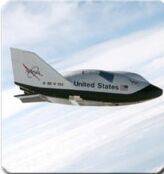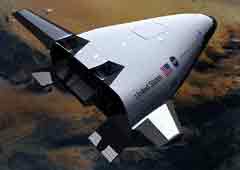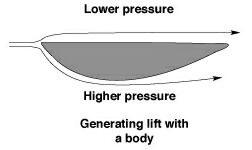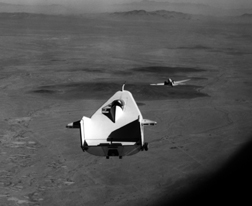


| Home | Bottom |
| SPACE | TRANSPORT: | Spacecraft Tech : | Lifting Body |



The concept of lifting body aircraft is all about generating lift from it's body itself without the aid of wings. Such aeroplanes use wings only for their stablising and steering effects. There are other concepts which fly using wings with the body contributing a smaller but significant amout of lift.
The lifting body is in some ways exactly opposite to the flying wing . But they are also similar in the sense that they do without either wings or a distinct body.

At NASA ,lifting bodies started off as a more efficient shape for missile warheads(such a warhead could fly and guide itself rather than simply falling on it's target). The scientists originally wanted a shape that could survive the atmospheric reentry more easily.

The first fruit of the initial studies was the M2. It was tested by towing it behind a car, and later by an aeroplane ( R4D / C-47 ) to allow free fall flights from 12,000 ft. Max speeds reached were 100 to 120 mph. A total of 400 ground tows and 77 flights were conducted. The M2-F1 was made of plywood.
The highly successful M2-F1 was followed by M2-F2,M2-F3,HL-10,X-24A and lastly the X-24B. These were all made of metal. They were droped from the same B-52 that was used in the X-15 program. M2-F3 reached an altitude of 71,500 ft and a speed of Mach 1.6. The HL-10 was the fatest and highest of all and reached Mach 1.86 and +90,000 ft. Power was derived from a rocket engine
The above vehicles proved that a spacecraft diving from space could land safely at a pre-determined runway. This paved the way for the space shuttle.
After more or less being forgotten, the lifting body staged a comeback in the form of viable space transport like the Venture Star, ISS Crew Return Vehicle (CRV) and the russian EKIP. The Venture Star, in concept as the X-33 was however cancelled in March 2001. Funds are not available for the rather amazing EKIP. The CRV program too was dropped out of NASA's budget. Without the CRV, the ISS will not be able hold more than 3 people at a time - the capacity of the Russian Soyuz space capsule.
Also See :
| Aircraft | : | Flying Wings |
| Spacecraft | : | NASA X-38 |
| Aircraft | : | Tu-404 |
| Aircraft | : | X-47 Pegasus |
| Content | Design | |
| venturestar.com : Official website of Lockheed Martin's proposed successor to the space shuttle. | 4/10 | 2+0+2.5/10 |
| dfrc.nasa.gov/gallery/photo/HL-10/index.html : HL-10 picture gallery. | ||
| dfrc.nasa.gov/gallery/photo/M2-F1 : M2-F1 lifting body picture gallery. | ||
| dfrc.nasa.gov/gallery/photo/M2-F2 : M2-F2 lifting body picture gallery. | ||
| dfrc.nasa.gov/gallery/photo/M2-F3 : M2-F3 lifting body picture gallery. | ||
| dfrc.nasa.gov/gallery/photo/X-24 : X-24 lifting body picture gallery. | ||
| dfrc.nasa.gov/PAO/PAIS/HTML/FS-011-DFRC.html : NASA's Lifting Bodies Fact Sheet. Traces history of development from the M2-F1 to the X-24B. No info on the newer X-38 and X-33. | 6/10 | 0+3/6 |
| dfrc.nasa.gov/PAO/PressReleases/pressReleases.html : Dryden News Releases | ||

Mail ST at [email protected] . Your suggestions are welcome.
| [ Home ] | [ Aircraft ] | [ Explore Space ] | [ Space Stations] | [ Spacecraft Tech ] | [ Spacecraft ] | [ X-Prize ] |
| © Space Transport | Top |